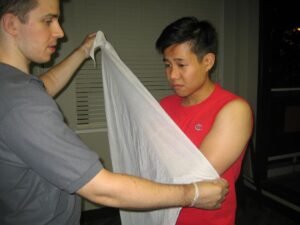An arm sling is basically a bandage that is utilized to provide support to an injured joint. In most cases, these slings are used once a joint is dislocated, damaged or injured due to surgery. Take note that the sling maintains the affected arm or shoulder motionless so that the muscles, tendons and bones can properly heal. When providing first aid care, it is important that you are also familiar with the types of arm slings that are commonly utilized for arm and shoulder injuries.
What you need to know about arm slings
An effective arm sling is made from a piece of a cotton triangular bandage that you can easily find in first aid kits. During an emergency, these slings can be crafted out of materials such as a clothing pieces or even a belt. In first aid scenarios where the type of injury is unidentified, slings can be used to immobilize temporarily the arm to prevent the injury from worsening as well as to provide relief from discomfort. Upon the application of the sling, it is vital to ensure that circulation is not disrupted in the arm that is being supported. Always check the pulse at the wrist or squeeze a fingernail to check for color change in the nail bed since it can indicate if the sling must be adjusted.

Types of arm slings
Standard arm sling
This is mainly used for injuries on the forearm such as sprains or fractures. This type of arm sling basically supports the forearm so that it will rest slightly parallel to the ground with the wrist higher than the elbow. It is slung over the shoulder on the unaffected side of the body and tied to secure in place.
Collar-and-cuff sling
The collar-and-cuff sling is utilized for upper arm injuries or if a dislocated collar bone is suspected as well as in cases when a standard bandage is not readily available. With this type of arm sling, the elbow naturally hangs at the side of the body while the hand of the affected arm is extended to the unaffected shoulder. A belt or strip of cloth is wrapped around the wrist of the affected arm and the ends are wrapped around the neck and tied to secure in place. In case additional support is needed, wraps or bandages can be applied around the body and upper arm to hold the arm firmly to the chest.
Shoulder or elevated sling
Slings are also utilized to provide support to the shoulder once it is injured. Just like with other types of slings, this is made from a triangular piece of cloth. The affected arm is positioned over it so that the top point of the triangle is at the elbow while the wrist rests between the other two points which are then brought up and tied behind the neck. There are also variations to this type of sling depending on the amount of immobility needed, but all are designed to limit the movement of the shoulder while the injury heals.
